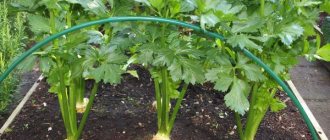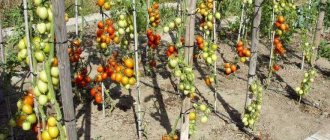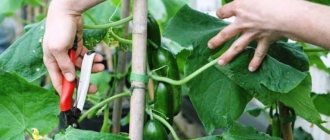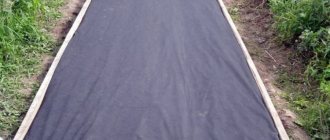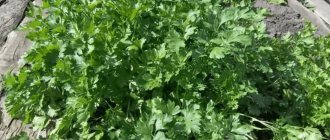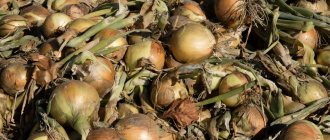When is it time to dig up celery roots?
Root celery is a short-day plant with a long growing season (120–150 days). It is on cool autumn days that the vegetable begins to actively grow and accumulate nutrients. In hot summer weather the crop hardly grows.
Deadlines
It is important to harvest root crops in time in order to prepare them for transportation and storage. They must ripen well, otherwise they will be tasteless and quickly become unusable. Due to the delicate peel, the root crop is prone to withering and rotting.
The vegetable is resistant to cold and even slight frosts on the surface, so do not rush to harvest. It is usually harvested in the second half of October.
Late varieties of root celery actively gain weight, taste, accumulate nutrients, and form a peel in October and early November. At the same time, you should not delay the event until real frosts, since the taste of frozen vegetables changes greatly.
Advice! If the celery is caught in frost before harvesting, it is not immediately brought into a warm place, but left at a positive but low temperature, no higher than +10°C, so that it does not rot.
Experienced gardeners recommend harvesting celery after a good rain. If the weather is dry, the beds are watered. Then, when digging up root crops, it will be possible to avoid their damage, which will affect the keeping quality.
By what signs can you understand that it is ripe?
The color of the tops will help determine the degree of maturity of root crops. If it starts to turn yellow and dry out, it means the celery has stopped growing and it’s time to dig it up.
What's good about celery?
The culture has been known and widely used since ancient times. Even in ancient Egypt, it was used to heal many diseases and “drive out evil spirits.” Initially, the vegetable was used exclusively as a medicine.
Celery is not very common in grocery stores. You can find it on the market, but, alas, the prices are steep. And there are a huge amount of vitamins and other useful elements in this vegetable! Therefore, it is worth introducing it into your diet more often. It is most profitable to grow celery yourself in the summer-autumn season with a reserve for storage in the winter.
Photo: Petiole celery.
The types of this vegetable are different depending on the organ used for food: petiole, leaf and root (root). Each of them has its own storage conditions and features.
Let's talk about the root type of this root vegetable. Whether dried, frozen or fresh, celery will significantly improve the taste of dishes and supply our body with useful elements. The celery organ contains useful substances: vitamins B, C, PP, essential oils, plant hormones, salts of useful metals, starch and a number of others.
Photo: Leaf celery.
Regular consumption of root vegetables improves immunity, protects the body from viruses, various infections, and removes waste and toxins. This is not a complete list of all the positive properties of celery root. The culture has unique properties: one branch replenishes a person’s daily requirement of vitamins and microelements.
Ripening dates in different regions of Russia
The timing of ripening and harvesting of root crops largely depends on the weather conditions of areas located in different climatic zones of Russia, and the varietal characteristics of the crop. It is important to plant a plant that will have time to ripen, and the harvest will be stored for a long time.
When to harvest celery in different regions of Russia:
- The Moscow region is characterized by clearly defined seasonality, high humidity, warm summers, moderately cold winters with stable snow cover and thaw. For these places, mid-early varieties of the crop are chosen, the ripening period of which is 140–150 days. Harvest occurs at the beginning of October.
- The Volga region is characterized by frosts in early spring and late autumn, snowy winters and hot summers, so it is better to plant early and medium varieties here. The harvesting period for celery in this region is September – October.
- For northern regions (Urals and Siberia) with a cold climate and frosty winters, early varieties are chosen for planting, and the harvest is harvested before mid-September.
- In the Krasnodar and Stavropol territories, where the southern climate is warm, varieties of late ripening (about 200 days) are grown. Root crops are dug up at the end of October.
The first experience of growing celery was unsuccessful
I really like to grow all kinds of herbs in my small plot: I not only pick dill, parsley, and celery fresh from the garden in the summer, but also dry, salt and freeze them for the winter. By the way, I had never heard of root celery before, because no one grew it here.
And about three years ago there was some kind of fashion for him. Well, I also bought seeds then, deciding that this was not a troublesome matter. I sowed them in boxes and was very pleased when the sprouts sprouted, and immediately moved them to the sun, on the south window.
And after a while I saw the result of my haste: my seedlings shrunk, withered and, no matter how hard I tried to bring them back to life, they died. I had to turn to my neighbors at the dacha for help - they are already retired, have a lot of time, are in no hurry, and so their seedlings turned out wonderful. After this incident, in the fall we began to agree on who grows what seedlings, so that later we can change, if anything happens. And no problems.
Well, now more specifically about my experience.
How to dig up celery root correctly
To avoid damaging the root crops when digging, it is better to use a fork or a flat shovel.
Attention! Simple pulling out is suitable only in case of quick use of vegetables: with this method of harvesting, the root vegetables are severely damaged, which reduces their shelf life.
When digging vegetables, it is advisable to grab a large volume of soil around, then the root system will remain intact. To do this, they retreat 10–15 cm from the root crop, dig it up and, grasping the tops, carefully remove it from the ground with their hands.
After harvesting, the root crops are sorted and their quality is checked: they must be hard, without damage or rot, small healed cracks are acceptable.
Before being sent for storage, the crop is prepared:
- Clean or shake off the soil.
- Wash in water and leave in the sun for 1-2 hours to dry.
- The entire green part is cut off at a distance of 2 cm from the base and left on the bed as fertilizer. When cutting tops, it is important not to damage the growing point.
- To prevent the cut areas from drying out and starting to rot, the vegetables are laid out in a shaded, ventilated area.
- Store in the basement, refrigerator or freezer.
Root vegetables with slight mechanical damage are not suitable for long-term storage - it is better to use them immediately.
When to sow seeds
Petiole and root types of celery are sown for seedlings in February or March. Late-ripening varieties should be sown earlier. Before planting, it is advisable to soak the seeds in a pink solution of potassium permanganate, rinse and place them on the bottom shelf of the refrigerator for 10-12 days, wrapped in a damp cloth. In this way, celery seeds undergo stratification and subsequently germinate faster and more efficiently.
Harvest storage
To keep celery fresh longer, create the following conditions:
- low temperature - 0...+4°C;
- optimal humidity is 80–90%.
Under such conditions, fresh vegetables are stored for 2 to 4 months (in a pit, cellar or basement).
There are many ways to extend the shelf life of a crop:
- In the apartment. In room conditions, the shelf life of celery is minimal - no more than 4 days. To prolong them, choose the coolest and darkest place (for example, a pantry) or place the vegetables in a box mixed with damp sand, cover with cling film and place under the window in the kitchen. The film is periodically removed to prevent vegetables from rotting due to lack of oxygen.
- In the country. They dig a hole, put root vegetables in it in one layer, sprinkle with sand and earth. The method is only suitable for areas with mild climates where the soil does not freeze in winter.
- In a basement, barn or cellar. Vegetables are placed in wooden boxes, covered with sand and lime, covered with sand and covered with clay. When it dries, the boxes are placed on racks and shelves.
- In a refrigerator. Celery is washed under running water, dried and packaged in plastic bags with holes for ventilation. Place in the vegetable compartment and keep at a temperature of +3…+6°C. This will keep the crop fresh and juicy for 10-30 days.
- In the freezer. To freeze vegetables, they are processed, cut into pieces and placed in a bag. Keep for up to 1 year.
Heat treatment and canning
How to store celery root in a city apartment where there is no cellar or basement? There are several ways:
- freezing;
- drying;
- pickling;
- pickling.
In the freezer
Frozen plants have the longest shelf life. An important rule is to wash, dry, and remove unusable parts. Cranberries are usually stored in the freezer.
Step-by-step instructions for storing in the freezer:
- cut the root into cubes, grate;
- chop the petioles into pieces of the required length;
- gather the leaves into a bunch or chop them;
- Place each type in portions into containers with a lid;
- to freeze.
This way, celery can be stored for up to 1 year.
After defrosting, the root becomes fibrous and partially loses its taste. It is not consumed raw, but is used for heat-treated dishes.
Features of storing celery root for the winter
Drying celery
When dried, celery cultures perfectly retain their beneficial properties, microelements, and nutritional value. They are especially good for aromatic seasonings in soups and sauces.
The leaves are the most tender part. Dry them whole or finely chop them. Spread out food paper, lay out the leaves in a thin layer and cover with gauze. The greens will dry in 5-7 days. It is then packaged in suitable containers with an airtight lid and stored on a shelf with herbs.
For roots and petioles, use an electric dryer or oven.
Freezing and storing petiole celery
Harvesting and storing leaf celery
Not only celery roots are used for food, but also other parts: long green petioles and upper leaves . The vegetable is rich in vitamins C, group B, carotene, organic acids, minerals and flavonoids. Therefore, it is important to preserve the value of the plant during harvesting.
Thus, it is recommended to harvest leaf celery before frost, since the leaves wither in the cold, losing all their beneficial substances. They are cut 2-3 times during the summer with an interval of 35–40 days. The maximum time for collecting leaves is late September - early October.
Important! Leaves must not be picked. They are cut with a sharp knife, leaving petioles at least 5 cm long. This will preserve the central rosette, which will grow again, and protect the root system from rotting in winter.
Cut leaves wither very quickly, so they are immediately washed, dried and stored:
- Clean leaves are wrapped in aluminum film and placed in the refrigerator. In this form, the preparation is good for 7–10 days. It is better not to use polyethylene, as after 3 days the greens will lose their color, taste and benefits.
- The greens are laid out on a white paper sheet and covered with the same on top. Over the course of a month, the celery is dried and then used as a seasoning.
- The leaves are crushed, placed in a plastic container and frozen.
- The greens are chopped and sprinkled with salt (100 g per 0.5 kg of leaves). Place in glass jars and seal.
Chereshkova
The petioles of the plant are cut several times during the growing season, when the length of the leaves reaches approximately 30 cm. The most suitable time for the last harvest is the end of September and the very beginning of October. A correctly chosen period allows you to preserve the unique taste of greens. The harvest is prepared for the winter.
Important! The main sign that the petioles are ripe is the appearance of white color and the disappearance of the spicy, pungent taste.
Bleaching is carried out before harvesting. It removes the bitter taste from the petioles and makes them more tender. For this:
- A few weeks before harvesting, the petioles are tied into a bundle.
- The lower part is wrapped in burlap or other breathable material.
- Before cleaning, remove the fabric.
Celery with yellow stalks does not need this procedure, as it is much more tender than other varieties.
How to store petioles:
- In the basement . During harvesting, celery is dug up along with the root so as not to damage it. The plants are wrapped in cloth and left there until they are sent to the basement, where boxes of wet sand are placed. When everything is prepared, the vegetables are placed in the sand. When storing in this manner, it is important to ensure good ventilation.
- In a refrigerator. Leaves and roots are removed from the petioles, washed well and left to dry. Dried plants are wrapped in cling film or foil and placed in the refrigerator.
- In the bank. The roots of the plants are cut off and placed in a jar filled with tap water. They leave it in the kitchen like this.
Celery will last about 7 days in a jar without refrigeration. Be sure to change the water daily and trim the stems a little.
Which celery is suitable for planting before winter?
Before winter, you can sow any celery - leaf, petiole, root, and it is recommended to sow root celery in this way, since the growing season of the crop is quite significant - 5-6 months. Plants sown in autumn will sprout 2-4 weeks earlier, which will extend the growing season and get a larger harvest.
Advice from experienced summer residents
To get a good harvest, be sure to treat the crop with compounds that protect against slugs (for example, “Thunderstorm”, “Slug Eater”).
To protect celery, the foliage is wrapped in paper or foil. This is especially useful when the plant is very lush. Thanks to the wrapping, the bushes will grow vertically, without falling apart or bending towards the ground.
After any feeding, vegetables are doused with water from a watering can or hose. There should be no fertilizer left on top of the leaves.
Planting celery in the ground
At the very end of May and even at the beginning of June, root celery seedlings can be planted on the “mainland”. First you need to prepare the soil. The soil, ideally, has been dug up and fertilized since the fall. If this does not happen, digging should be carried out in the spring, no later than two weeks before planting the celery seedlings. Also, during the spring digging, it is necessary to add high-quality mature humus and a complex of minerals (nirofoska, azofoska).
Celery needs fertile soil
- Planting pattern – 20x30 cm.
- The soil is well watered before planting.
- When moving a seedling from a pot into the ground, try not to destroy the lump of earth.
- Plants should never be buried in the soil.
- After transplanting, the seedlings are watered again.
It is better not to rush into planting root celery in open ground, but to wait until mid-May, when the weather is more or less warm.
Planting celery in the ground and watering
When the seedlings take root well, young leaves will begin to grow. At this time, the root celery needs to undergo surgery to remove the lateral roots. To do this, you need to rake the soil away from the stem so that the horizontal roots, which are close to the soil surface, are exposed. These roots need to be trimmed with a knife. The cutting depth is about 5 cm. This procedure can be carried out twice. If the lateral roots are not trimmed, the tuber will grow “bearded” and “horned”.
Trimming the lateral roots of a root crop
Celery root leaves are usually left in place to achieve a larger yield. But it is still recommended to remove the lower leaves. If you leave them, the root crop will not be voluminous, but “flat”.
